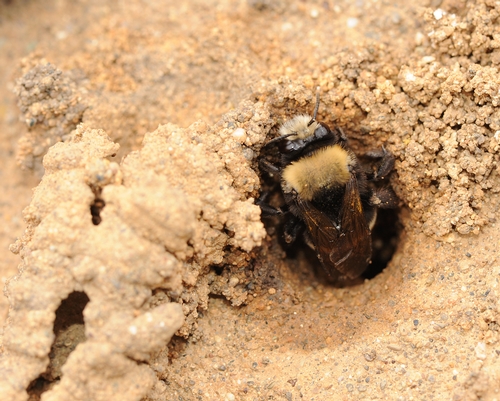- Author: Kathy Keatley Garvey
There's more to Sonoma County's Bodega Head than the stunning views, crashing waves, nesting seabirds, and bursts of flora and fauna.
The sand cliffs are also the home of a digger bee, a bumble bee mimic known as Anthophora bomboides stanfordiana.
"The species name indicates that it is a bumble bee mimic," the late Robbin Thorp, a global authority on bumble bees and a UC Davis distinguished emeritus professor of entomology, told us several years ago. "These bees need a source of fresh water nearby. Females suck up water, regurgitate it on the sandstone bank surface, then dig away at the soft mud. They use some of the mud to build entrance turrets, presumably to help them locate their nests within the aggregation of nests."
"The female," Thorp said, "sucks up fresh water from nearby, stores it in her crop (like honey bees store nectar) for transport to the nest. She regurgitates it on the sandstone, and excavates the moistened soil. She carries out the mud and makes the entrance turret with it."
On multiple trips to Bodega Bay over the years, we watch in fascination as the bees excavate their homes, zip in and out of their turrets, and nectar on nearby flowers.
This time (June 24) we photographed an ant and bee encounter on a turret. The ant? Formica transmontanis, according to ant specialists Phil Ward, professor of entomology at UC Davis, and UC Davis alumnus Brendon Boudinot, who recently received his doctorate from UC Davis, studying with Ward.
"The species nests on the bluffs," Ward told us.
And about that bee-ant encounter? Commented Boudinot: "I suspect the little lady was alarmed by the big bee. These ants and their relatives are rather passive scavengers except during the brooding season, when fresh meat is an order. Most entomeat for Formica tend to be free-walking insects than barricaded larvae, as probably for the bee. For these reasons I think that the encounter may be coincidental!"
Scores of UC Davis entomologists have engaged in research at Bodega Bay. Rachel Vannette, assistant professor, UC Davis Department of Entomology and Nematology, is currently researching Anthophora bomboides stanfordiana and its nests as part of a National Science Foundation grant. Her project on solitary bee provision microbiome includes investigating the diverse community of bacteria and fungi in the provisions and brood cells.
While COVID-19 mandates and precautions hamper her research team's efforts (she's done some preliminary sampling this year and the entire team is planning to do research next year), the digger bees of Bodega Head keep digging, crafting turrets, nectaring on the nearby flora--and encountering ants.
They're all in this together.
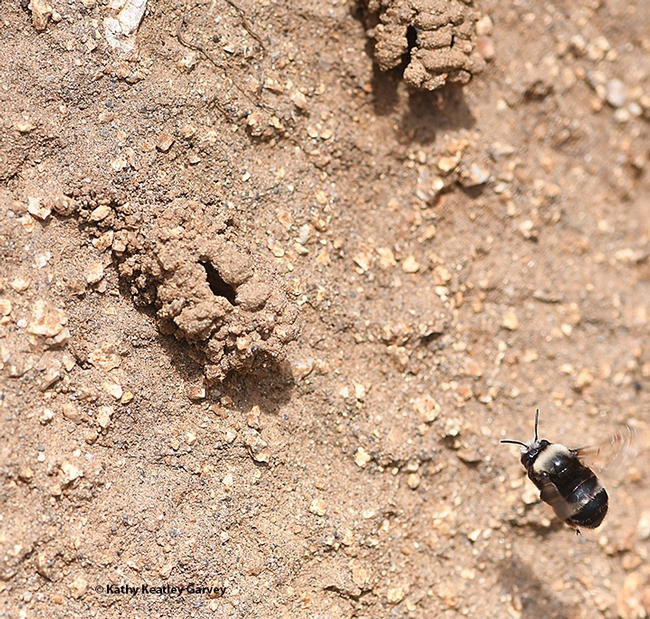
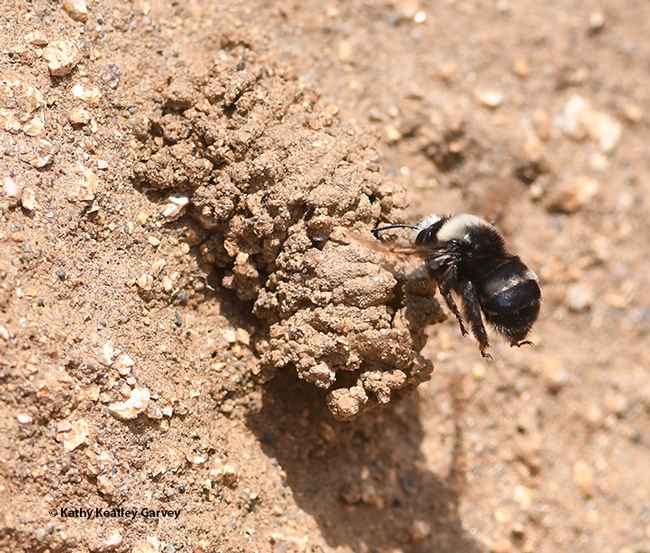
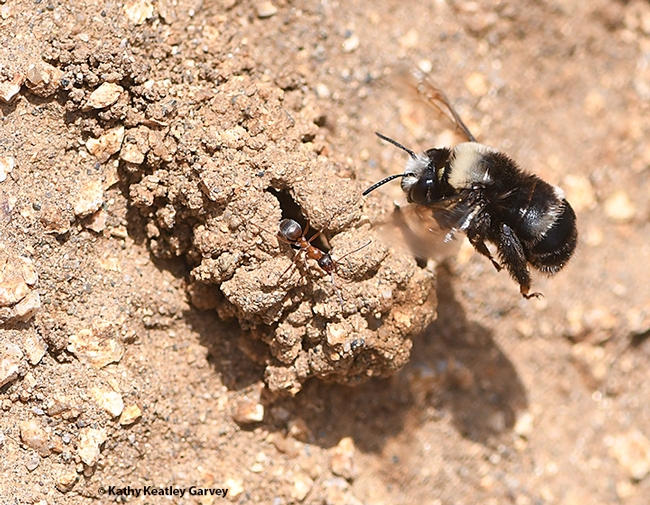
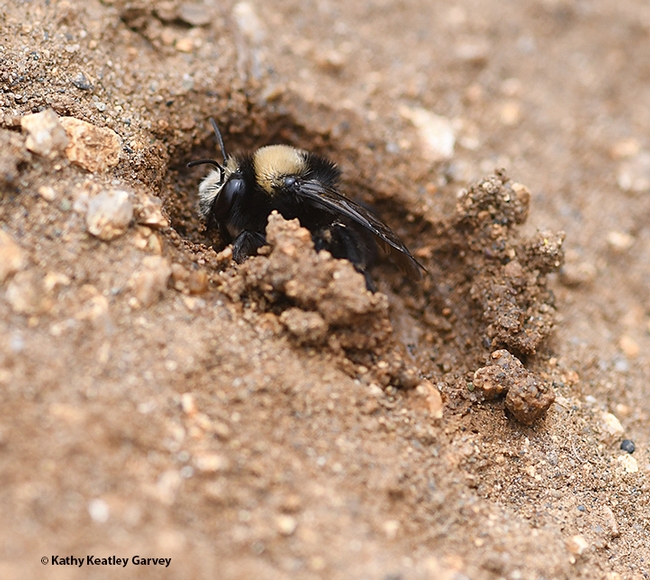
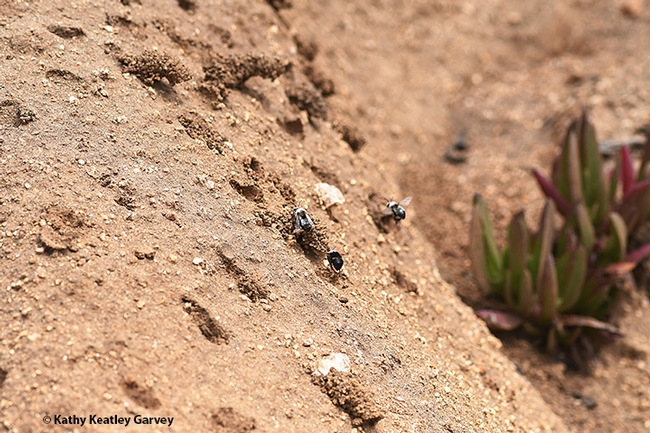
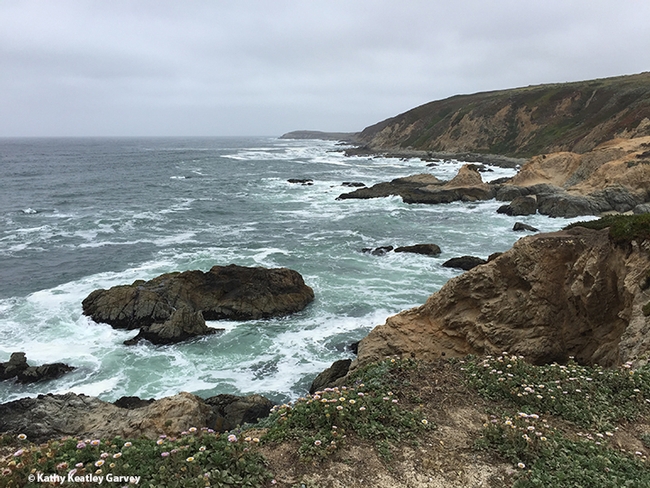
- Author: Kathy Keatley Garvey
If you're walking along the cliffs of Bodega Head, Sonoma County, you may overlook them.
While you're watching for whales, scouting for seabirds and checking out the hikers, there's a lot of movement in the seaside daises (Erigeron glaucus) and seaside woolly sunflower (Eriophyllum staechadifolium).
Green-eyed bullets with spectacular abdominal stripes zero in on the flowers, grab some food (this really is "fast food") and then take off at break-neck speed.
They're sand wasps, Bembix americana, so named because they dig nest holes in the sand. They belong to the family Crabronidae, subfamily Bembicinae, tribe Bembicini (sand wasps), subtribe Bembicina, and genus Bembix. They're quite common in North America. We've seen them from Fort Bragg to Bodega.
They're not vegetarians, like our honey bees. Like all wasps, they're carnivores. They're hunters. They're predators. They prey upon small insects, such as flies. The sand wasps then carry their prey back to their nests.
So while you're watching for whales, watch the flowers. If they move, it may be more than just the wind.
Want to read more about sand wasps? Entomologist Richard Bohart (for whom the Bohart Museum of Entomology at UC Davis, is named), and his former graduate student, Arnold Menke, wrote about them in their book, "Sphecid Wasps of the World," published in 1976 by the University of California Press, Berkeley.
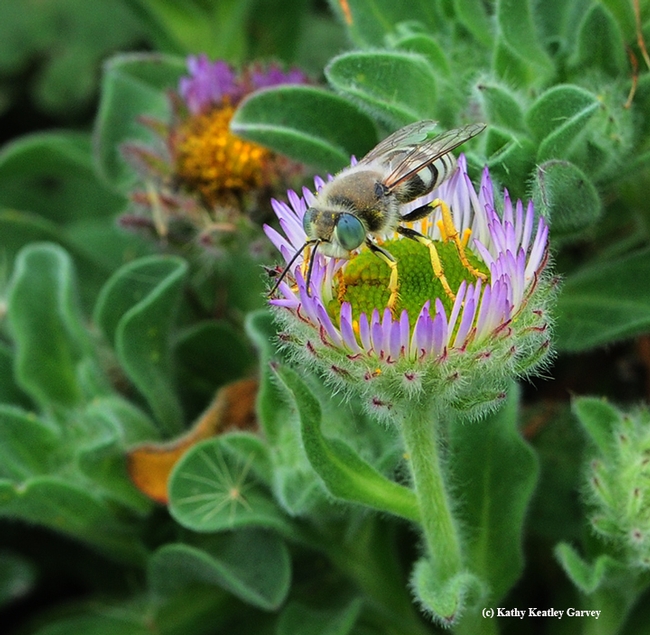
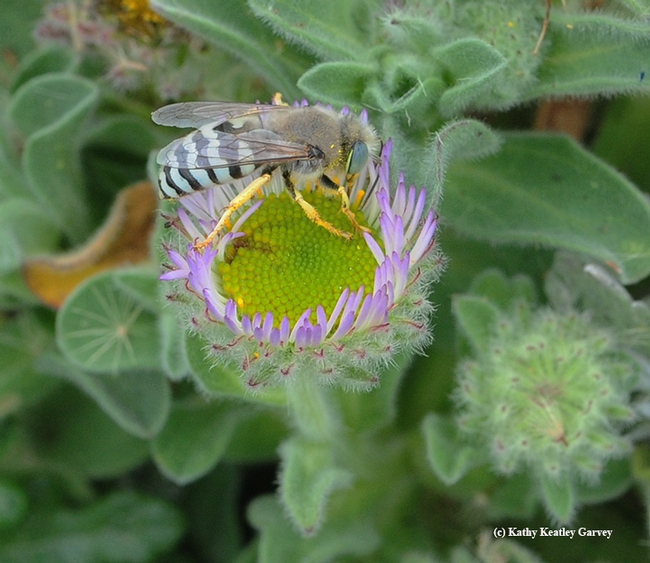
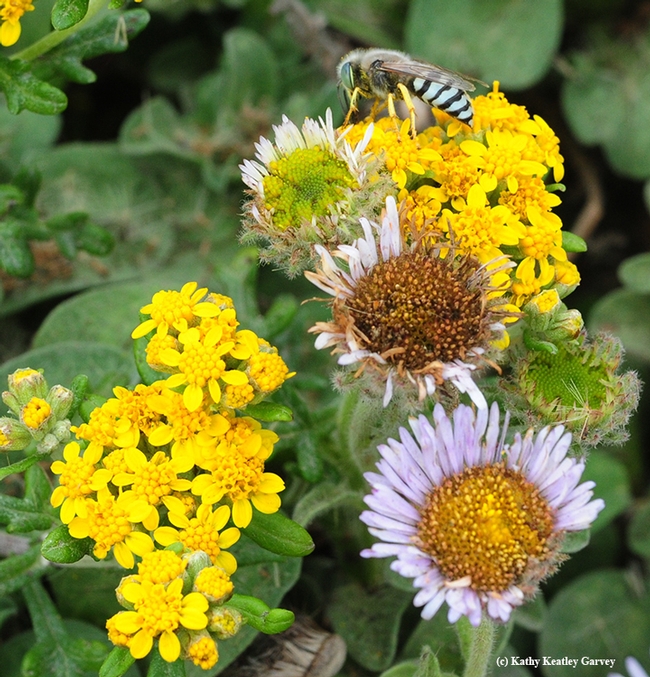
- Author: Kathy Keatley Garvey
If you're planning to hike the hills around Bodega Head in Sonoma County, watch out for the bears.
The woolly bear caterpillars, that is.
Last Sunday, with the temperature hovering around 70 degrees, the woolly bears were everywhere. They were munching on the gray-green leaves of Lupinus arboreus (yellow bush lupine), not yet blooming. We also spotted them on yellow mustard and wild radish, both members of the Brassicaceae family and both abloom.
If you look closely at these little caterpillars, they seem to be having a bad hair day. They look as if they just encountered a jolt of static electricity.
They're also known as the larvae of Ranchman's Tiger Moth (Platyprepia virginalis). Once they become moths, they do not resemble woolly bears any more.
Rick Karban, professor of entomology at UC Davis, has published a number of research papers on these herbivores.
"Platyprepia virginalis caterpillars are dietary generalists and feed on multiple host species within a single day," he wrote recently in Ecological Entomology. "We conducted field experiments to evaluate their performance on diets consisting of only their primary food, Lupinus arboreus, or diets consisting of L. arboreus plus other acceptable host species."
"We found that relative growth rates and rates of survival were higher when they fed on mixed diets compared to lupine only."
That feeding behavior we saw, too. A lupine lunch, with a touch of mustard and radish.
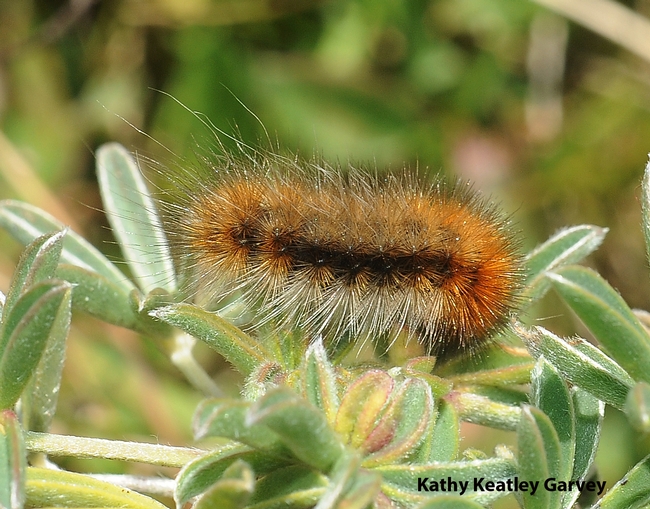
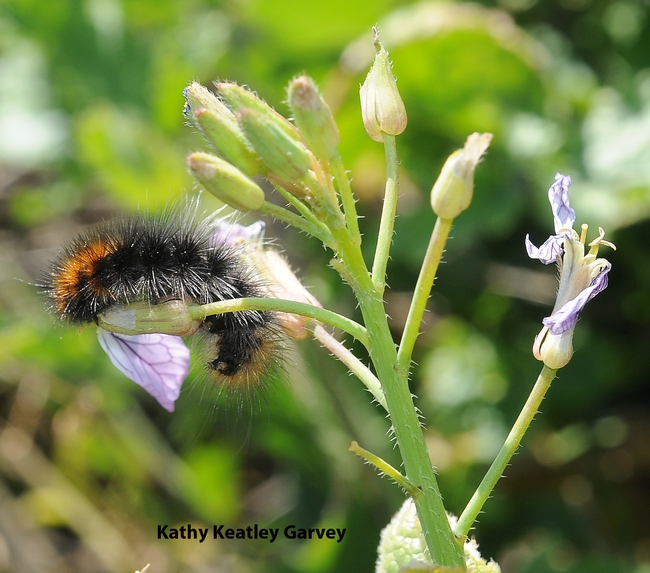
- Author: Kathy Keatley Garvey
If you enjoy climbing the cliffs of Bodega Head on the Sonoma coast, keep your eyes out for bears--wooly bear caterpillars, that is.
The so-called "wooly bear caterpillar" is reddish, black and woolly and has a voracious appetite much like that of Joey Chestnut. It is the Ranchman's Tiger Moth caterpillar, Platyprepia virginalis, now changed to Arctia virginalis.
Richard "Rick" Karban, professor of entomology at the University of California, Davis, studies this critter. "It has a taste for most alkaloid containing plants, like fiddleneck, although it doesn't appear to sequester the alkaloids," he told us. "The alkaloids may help caterpillars survive their parasitoids, however."
We saw about five of the wooly bear caterpillars on a public trail near the Bodega Marine Reserve above the Bodega Marine Laboratory on April 17.
The reserve, which surrounds the Bodega Marine Laboratory, is a unit of the University of California Natural Reserve System and is administered by UC Davis.
Several wooly bear caterpillars were munching on fiddleneck. Another rolled around near a patch of California poppies and we couldn't tell what its menu included. It looked good, though!
You can read Karban's research on "Diet Mixing Enhances the Performance of a Generalist Caterpillar, Platyprepia virginalis," published last February in the Ecological Entomology journal.
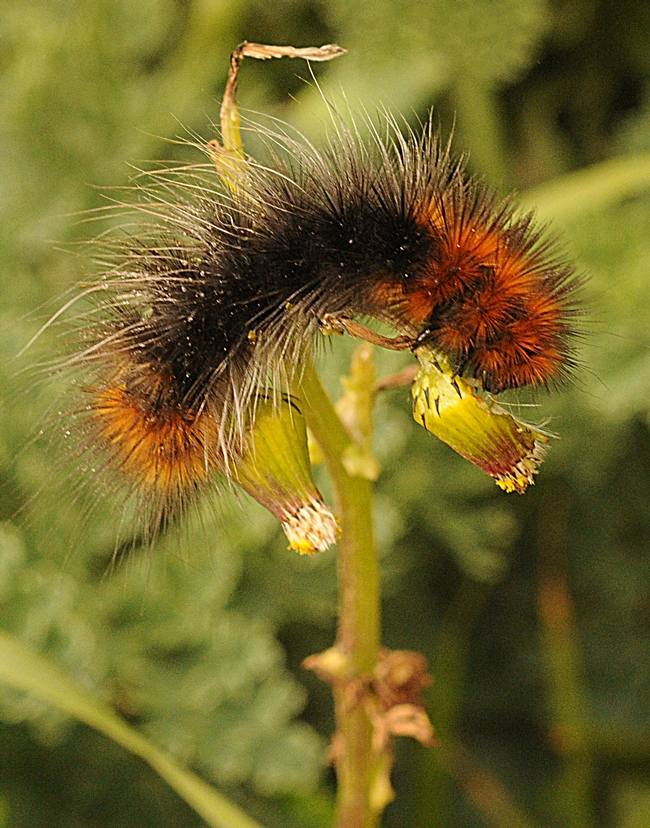
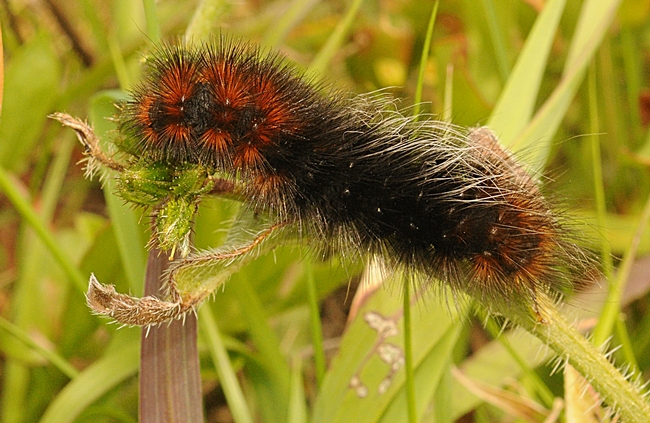
- Author: Kathy Keatley Garvey
They're populating the sandy cliffs of Bodega Head, Sonoma County. A sure sign of their presence: dense clusters of turrets.
When they're not foraging among the wild radish (genus Raphanus), lupine (genus Lupinus) and other plants, these ground-dwelling bees are digging nests and rearing their young.
"The female sucks up fresh water from nearby, stores it in her crop--like honey bees store nectar--for transport to the nest," said native pollinator specialist Robbin Thorp, emeritus professor of entomology at the University of California, Davis.
"She regurgitates it on the sandstone, and excavates the moistened soil," he said. "She carries out the mud and makes the entrance turret with it."
The digger bees are sometimes referred to as "alternative pollinators," but they're all members of the Apidae family, which includes honey bees (the super pollinators), bumble bees, carpenter bees, sunflower bees, orchid bees, cuckoo bees and the like.

